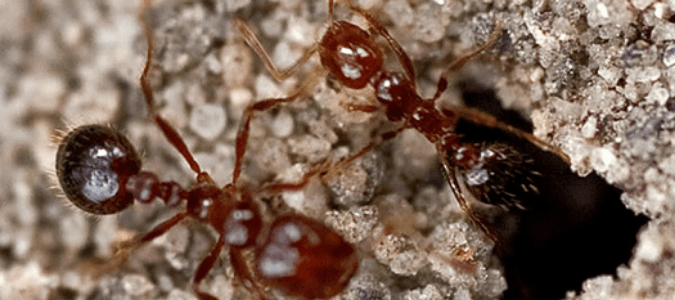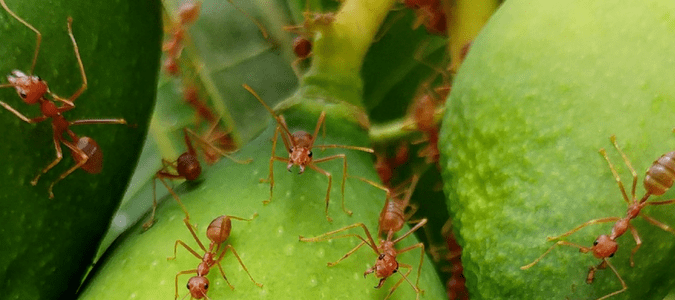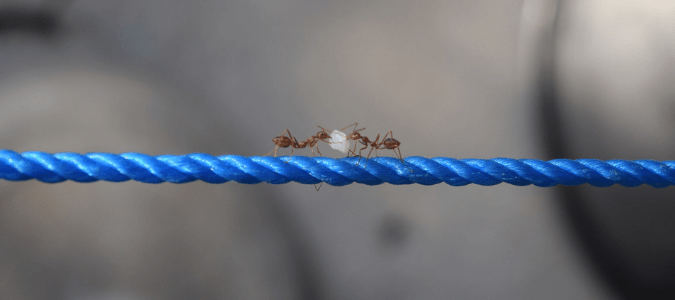They say everything is hotter in Texas. That’s usually in reference to the weather and the food, but it can also apply to the burn you feel when you’re bitten by fire ants. If you spend any time outdoors, you’ve probably been bitten by these insects at least once or twice. They get their name from the fiery sensation caused by their bites.
Unfortunately, fire ants are an especially aggressive species of ant. That means you aren’t imagining it: When their nest gets disturbed, they will come after you, fast. Their bites sting and burn, and they can also cause raised, pus-filled blisters on the skin.
Interestingly, these ants don’t just bite people—they bite first to grab hold of you, and then they curl their abdomens under to sting your skin. It’s actually the venom in their sting that causes the painful, burning sensation. Their stingers are at the tip of their abdomens and are always out, at the ready. A single ant can sting you multiple times.
What Do Fire Ants Look Like?
How can you know if the ants you’re seeing are fire ants? The ants themselves grow to about an eighth of an inch long. Their bodies are a dark reddish-brown or reddish-black color. If you looked at this type of ant under a magnifying glass, you would probably see its tiny stinger at the end of its abdomen. Their stingers are too small for most people to see with the naked eye, though.
Fire ants build colonies, also called mounds or piles, in the dirt outside. Their colonies look like rounded, fluffy mounds of dirt. These mounds don’t have a hole in the center, like some ant piles do. Instead, they might be dotted all over with tiny holes. They also might not have any apparent holes. They might just look like piles of loose soil that’s been worked over.
Fire ants often build their mounds in the middle of a yard or field, but they might build them against the foundations of buildings. They prefer full sun, but they also sometimes build colonies in covered spaces. You might find an ant mound inside your AC unit or an electrical box. You might also be surprised by one underneath an overturned flowerpot or children’s toy that has been left in the yard.
Why Are Fire Ants More Noticeable After a Rain?
Many people notice fire ants more often after it rains. This is because these ants move their nests underground when it’s dry out, in search of water and to get away from the heat. Then, when it rains, they come back to the surface with their young, to keep from drowning.
This swarming activity happens most often during the spring, summer and fall. When it’s been dry for a while and then it rains, winged ants called reproductives swarm out of their existing colonies. They find mates, build new dirt mounds and establish new colonies.
After a rain is also when these ants are most likely to invade your home. Like other pests, fire ants get inside through tiny cracks or gaps found in your foundation, or around exterior doors and windows. They can also get in through the spaces around any vents or hose bibs. They come inside in search of water and food they can bring back to their nests.
It’s alarming to find fire ants inside your home, especially if you have young children or pets. These ants’ bites are painful and annoying for anyone, but they can cause a lot of trouble for certain people and animals. People or pets that are allergic to the ant venom can get very sick from these ants’ bites. Dogs can also develop rashes from fire ant bites that need attention from a veterinarian.
Since fire ant bites are so painful and turn into raised bumps, people tend to scratch them a lot. Scratching bites can lead to secondary problems in the form of serious infections like staph or MRSA.
How to Get Rid of Fire Ants
There are many reasons to want to get rid of fire ants when they show up in your home or yard. Many people set out ant baits when they find these ants in their homes. You can also buy products to sprinkle around mounds outside. These products should be used carefully, since they can be toxic for people and pets if they aren’t used correctly.
There are also DIY methods you can find on the internet, such as using baking soda to kill ants. However, use caution. If these ants see you as a threat, they may end up covering you in bites.
The best time to treat fire ants and their mounds is during spring or summer, after a rain. This is when these ants are most active and visible. If you don’t treat a mound soon after it forms, it will grow in size and population. Fire ant colonies can sometimes have multiple queens. If a colony is left untreated, an extra queen might split off with a few workers and start a new mound nearby.
To destroy a fire ant colony, the queen or queens have to be killed. A pest control professional can treat the fire ants as well as eliminate the mounds and the queens living inside. This should keep the ants from coming back.
Unfortunately, fire ants can travel a hundred feet or more to establish a new colony. That means fire ants might come into your yard from a neighbor’s yard. This is where it’s helpful to schedule follow-up visits from your pest control professional, to make sure you prevent fire ants from building a new nest on your property.
Where Do Fire Ants Live?
Many people ask pest control professionals, “Where do fire ants live?” Fire ants actually aren’t native to the United States. They are an invasive species that originally came to the U.S. from Brazil, less than 100 years ago. Now they’re found across the southern and western U.S. They have been found as far southeast as Florida, as far north as Virginia, and as far west as California.
Fire ants live together in colonies that have one or more queens as well as workers. Workers are the ants that travel out of the colony to find food and bring it back for the other members. Workers are also responsible for building the mounds—the piles of dirt that house a fire ant colony. They also take care of the queen and defend the colony when threatened.
If you’ve ever poked a fire ant colony with a stick, you probably saw ants swarm out almost instantly. These were likely to be the workers. These ants move fast, and are very aggressive as well as protective. If you’re standing anywhere close to the mound when it’s disturbed, you’re almost sure to receive a bite or two.
What if I Found a Fire Ant Indoors?
Indoors, you’re also likely to be bitten if you encounter one of these ants, but you’re less likely to see an actual mound. This is because they are probably inside your home foraging for food. When they find what they need, they’ll take it back outside to the other members of their colony.
Sometimes, these ants build mounds within interior wall voids. Most often, though, they want to be outdoors in full sunlight. They are more likely to build their mounds up against your house. They’ll use weep holes and tiny cracks in the foundation to travel from their home into yours and back again.
You might not realize you have fire ants on your property until you see one inside. If you see fire ants indoors, it’s time to call in a professional to deal with the problem. They will be able to treat the ants inside as well as find their colony, wherever it’s located outdoors. A pro will also be able to find where the ants are getting in. They can recommend fixes like caulk or steel wool to close off cracks and gaps and keep pests out.
What Do Fire Ants Eat?
Many people wonder what fire ants eat. Often, they’re surprised to learn that these ants actually eat a lot of other insects that we consider pests. Fire ants actually eat lots of different things, including plant and animal material. Inside your home, fire ants eat things like sweets, carbohydrates and grease. This is why you’re most likely to find them in your kitchen, where they are hard at work finding crumbs to bring back to their nests.
Indoors and outdoors, fire ants eat fleas, ticks, spiders and even cockroaches, along with lots of other insects. In that way, they are a friend to anyone who doesn’t want these pests around! But most people consider fire ants pests as well, and for good reason. No one wants to accidentally disturb a mound and pay for it with itchy, painful fire ant bites.
Your best bet for getting rid of fire ants is to hire professional help. This is because these ants move fast, both in fleeing danger and in building new mounds. They are really good at surviving lots of adverse conditions. A pest control specialist knows where to look for fire ant colonies, even hidden ones, and how to treat these pests. With the help of a pro, you can reclaim your yard for your own enjoyment.
ABC Can Treat the Fire Ants on Your Property
Discovering a fire ant colony on your property is concerning for many reasons. Fortunately, ABC Home & Commercial Services can help. Our professionals will create a pest treatment plan that leaves you and your family feeling comfortable again.



